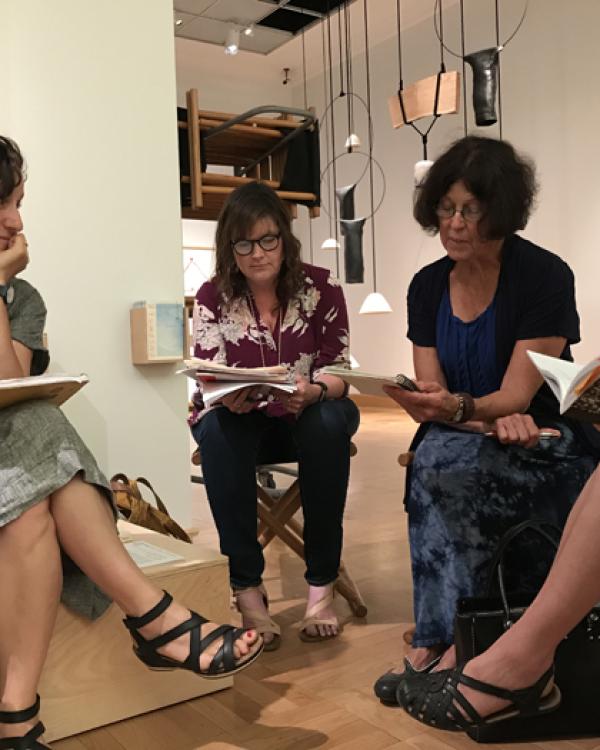
SCWriP at the Santa Barbara Museum of Art
To call the South Coast Writing Project (SCWriP) just a professional development program is akin to insisting Toni Morrison was a scribbler or José Andrés a cook. For SCWriP also runs a series of Young Writers Camps each summer, works with other subject area projects like those in mathematics and science to strengthen cross-curricular teaching and learning, and even leads an annual course on writing instruction for UCSB Teacher Education Program (TEP) students.
But SCWriP is probably best known for its Summer Institute, and not just because this past summer it conducted its 40th. This four-week think-tank brings teachers from all grade-levels K to college and across all disciplines to the Education Building at UCSB. Collaboratively they investigate best practices in writing and literacy instruction through shared demonstrations of practice, readings, and an intense focus on the group’s own writing and reading processes.
“I was writing a one-minute-sneeze, programming a robot, attempting slam poetry, and drawing a monster—happily discovering this is all a typical day at UCSB’s Summer Institute,” says participant Cie Gumucio, who admits that as a poet/teacher with Cal Poets in the Schools, she wasn’t a typical SCWriP fellow. “Each day began with the other teachers and a morning writing,” she continues, “After lunch, we might discover technology’s place in the classroom via answer-clouds, writers’ resources on Twitter, or discover the many joys of multi-genre writing.”
Despite the robots and technology, SCWriP Director and institute leader Tim Dewar (Ph.D., Education, ’08), who is also an Associate Teaching Professor in Education and TEP, insists that someone dropping in from that first summer in 1979 would feel at home. “While this summer felt new, and we had another interesting mix of teachers, anyone from the forty years would have recognized it,” he asserts. “There was reading, writing, laughing, crying, eating, and sharing of practice.”
Just as in the beginning years of the institute, every day started with writing. “That time felt sacred,” Dewar claims. “There is a unique feeling in a room of people all writing. And most of the time this year, people were writing by hand.”
Dewar, who is also currently the Executive Director of the California Writing Project, finds the values that helped fuel the first summer institute just as valuable today. “Our two basic tenets are ‘the best teacher of a teacher is another teacher’ and ‘to be a teacher of writing, you must write,’” he says. And that’s what the fellows do for four weeks. Dewar insists, “If we want educational improvements in the classroom, that’s shoulder-to-shoulder work, not top down. It happens when teachers work together.”
Gumucio echoes his assertion recalling her own experiences this summer. “Beyond exposure to a variety of wonderful teaching styles and lesson plans, my SCWriP experience underscored the value of the experiential and the importance of connection in the classroom,” she says. “I was inspired by dedicated teachers who dialogue with their students through journaling, empathy-building through theater techniques, and the concept that Risk = Growth for teacher and student alike.”
For SCWriP is all about building, growing, improving, learning, sharing. Dewar quips, “If we were starting the Summer Institute today, we’d be expected to hold a code-a-thon to develop an app so we could monetize student writing as ‘data.’” Instead, the institute is more than anything a space and time for teachers to talk to teachers…and not just for 15 minutes in the break room. “A Fellow a few years ago called us the last of the Commons,” Dewar recalls with a smile. “And it’s true. We think every teacher, and student, should have access to the resources for the best teaching of writing. We’re not Teachers Pay Teachers—whatever that is. We’re the opposite. Our motto is more like ‘Take what you need and share what you learned when you used it.’” SCWriP’s actual tagline is “Teaching. Writing. Excellence.” And for 40 years it’s been an indefatigable resource for the sharing of excellent teaching of writing.